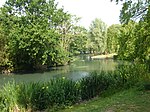Little Russia, London
Little Russia was an area of Tottenham, London, England. It was on the straight northern boundary of the London Borough of Haringey, specifically adjoining Edmonton, mainly comprising Pretoria Road, Durban Road, and Lorenco Road (west of the railway line between Silver Street and White Hart Lane). The area had become known as "Little Russia" in the early 20th century due to the influx of Russian immigrants. Immigration peaked when a large number of Russians settled there after fleeing the 1917 Russian Revolution. It developed into one of the toughest areas of North London, and the local constabulary usually only policed the area in pairs. The area was mostly redeveloped in the 1970s.
Excerpt from the Wikipedia article Little Russia, London (License: CC BY-SA 3.0, Authors).Little Russia, London
Durban Road, London Tottenham (London Borough of Haringey)
Geographical coordinates (GPS) Address Nearby Places Show on map
Geographical coordinates (GPS)
| Latitude | Longitude |
|---|---|
| N 51.608 ° | E -0.072 ° |
Address
Durban Road
Durban Road
N17 8ED London, Tottenham (London Borough of Haringey)
England, United Kingdom
Open on Google Maps






